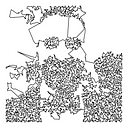“The computer may be potentially as valuable a tool to the arts as it has already proven itself to be in the sciences” Michael Noll
Generative Art Recoded is an effort to preserve pioneering generative artworks by translating them into a modern programming language (Processing). Indeed, in most cases, the original code underlying these early masterpieces got lost, unfortunately. My goal is also to offer a learning resource of Processing for both art and science students using the same challenging process I followed:
- start from the original artwork;
- reverse engineer the code;
- match the outcomes of the code with the original artwork and possibly tune the code accordingly;
- tweak the code to obtain derivative versions of the original.
Some of the derivative works I obtained, including the reversed code itself, are tokenized as non-fungible tokens. A non-fungible token, also known as a nifty or NFT, is a special type of cryptographic token which represents something unique and is saved and preserved on an immutable and, hopefully, eternal blockchain. I tokenized the artworks on the Ethereum blockchain by means of SuperRare and KnownOrigin, and MakersPlace, marketplaces.
Incidentally, I later discovered there is a community-driven Recode Project with similar aims.
Schotter (Gravel), Georg Nees, 1968
Georg Nees (born 1926, Nuremberg) is considered one of the founders of computer art and graphics.
Nees studied mathematics and physics at the universities of Erlangen-Nuremberg and Stuttgart. He subsequently worked for Siemens as a software engineer, and was instrumental in their purchasing a ‘Zuse Graphomat’, a drawing machine operated by computer-generated punched tape. The machine was capable of creating geometric patterns and, although the programming language that Nees used (ALGOL) was designed specifically for scientific computers, Nees used it to create aesthetic images such as this one.
In 1969 he received his doctorate on the subject of Generative Computer Graphics under Max Bense, the German philosopher and writer.
Along with a number of other practitioners working at this time, Nees was interested in the relationship between order and disorder in picture composition. Here he introduced random variables into the computer program, causing the orderly squares to descend into chaos.
Computer Composition With Lines, Michael Noll, 1964
In 1914 the Dutch painter Piet Mondrian (1872–1944) introduced a horizontal-vertical theme into his paintings which later culminated in the black-and-white painting Composition With Lines (1917). These paintings are said to incorporate masculinity and femininity by symbolizing the masculine as vertical (the upright trees of a forest) and the feminine as horizontal (the sea) with each complementing the other. Composition With Lines consists of a scattering of vertical and horizontal bars which, at first glance, seem to be randomly scattered throughout the painting. With further study, however, one realizes that Mondrian used considerable planning in placing each bar in proper relationship to all the others. Conceivably, Mondrian followed some scheme or program in producing the painting although the exact algorithm is unknown.
A. Michael Noll (born 1939, Newark, New Jersey), is a pioneer in generative art along with Frieder Nake and Georg Nees. He created a computer-generated version of Piet Mondrian’s Composition With Lines (1917) to determine whether computers could mimic artistic creativity. Reproductions of both pictures were then presented to 100 subjects whose tasks were to identify the computer picture and to indicate which picture they preferred. Only 28% of the subjects were able to correctly identify the computer-generated picture, while 59% of the subjects preferred the computer-generated picture. The study was published in The Psychological Record (1966). The following excerpt of the paper is particulary interesting:
Digital computers perform arithmetic operations with numerical data under the control of a set of instructions called a program. If this numerical data were the coordinates of end points of lines, then the computer could be programmed to numerically specify a picture. This numerical data could then be used to position and move the beam of a cathode ray tube to trace out the desired picture. In this manner, an IBM 7094 digital computer has been programmed to generate pictures using a General Dynamics SC-4020 Microfilm Plotter. The picture drawn on the face of the cathode ray tube is photographed by a 35 mm camera which is also under the control of the microfilm plotter. The microfilm plotter is presently limited to producing black and white pictures composed of connected and disconnected line segments. Mondrian’s Composition With Lines, a black and white painting composed of vertical and horizontal bars, was a type picture that the microfilm plotter was capable of reproducing with suitable programming of the computer.
Hommage à Paul Klee, Frieder Nake, 1965
Frieder Nake is a mathematician, computer scientist, and pioneer of computer art. Hommage à Paul Klee was created from a plotter drawing using a computer program written by Nake. It is based on a painting by Paul Klee, entitled High Roads and Byroads, dated 1929. Nake took Klee’s exploration of proportion and the relationship between the vertical and horizontal lines of the painting as the starting point for his algorithm. Nake then generated the drawing using a pen plotter (at this time, computers had no screen on which the image could be visualised). By deliberately writing random variables into the process, Nake also allowed the computer to make certain choices within a given number of options.
Vera Molnar, (Dés)Ordres, 1974
Vera Molnar, born 1924 in Hungary, is one of the pioneers of computer and algorithmic arts. Molnar learned the early programming languages of Fortran and Basic, and gained access to a computer at a research lab in Paris where she began to make computer graphic drawings on a plotter.
Disorder in the fault of a system has always evoked Vera Molnar’s interest. She reflected on the influences that a minor implication of disorder had on regular systems and on the role of random in the process of creation.
